Company Property
The Authentication Company Property Screen displays information about devices owned by a company that can be assigned to an employee for daily use (for example, printers, IP phones, laptops, tablets), and is used to create, edit, and delete property information.
To access the Company Property screen, click on Network Access > Accounts > Company Property under the “Configure” section of the OmniVista Cirrus Menu.
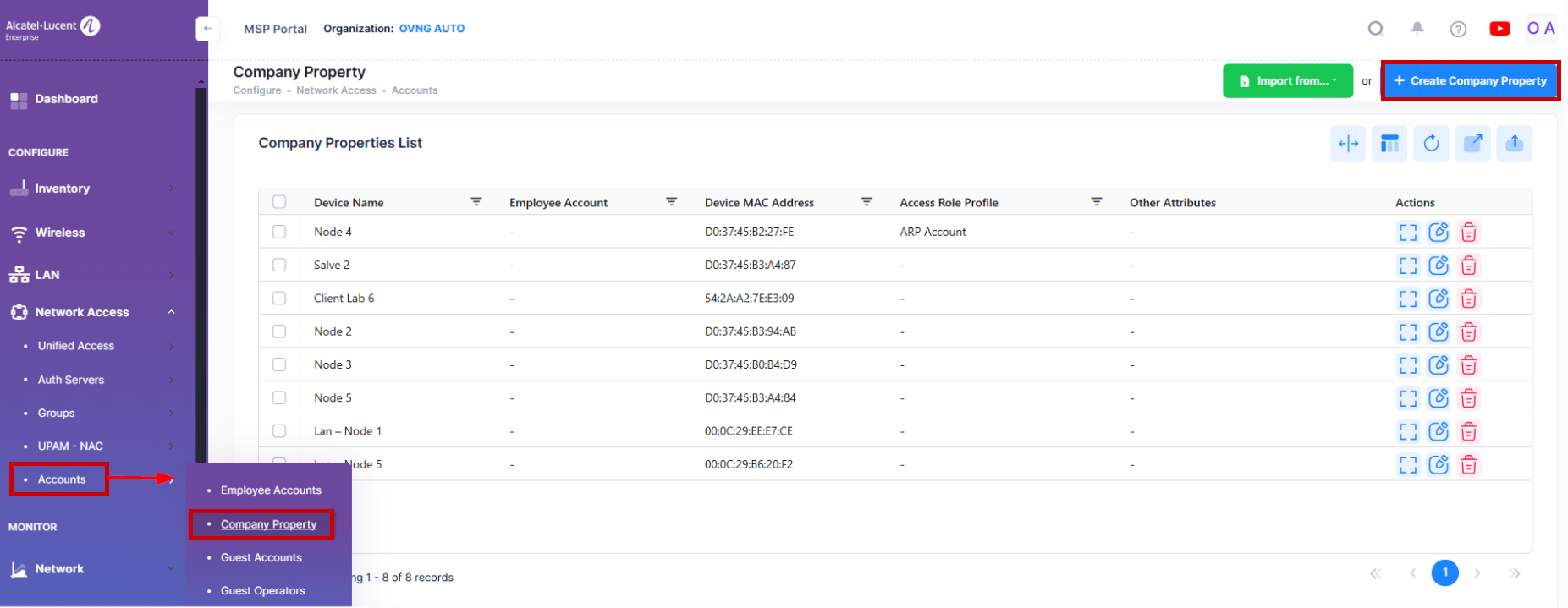
Data displayed in the Company Properties List can be exported into a CSV, PDF or Excel sheet format. You can also display the list in full-screen mode for a better display.
Creating a Company Property List Entry
There are three methods for creating a Company Property List entry for a UPAM network: Import an Excel XLSX file, Import a CSV file or manually add a Company Property.
Manually Add Company Property
To manually add a new Company Property List entry, click on Create Company Property to display the Create Company Property screen.
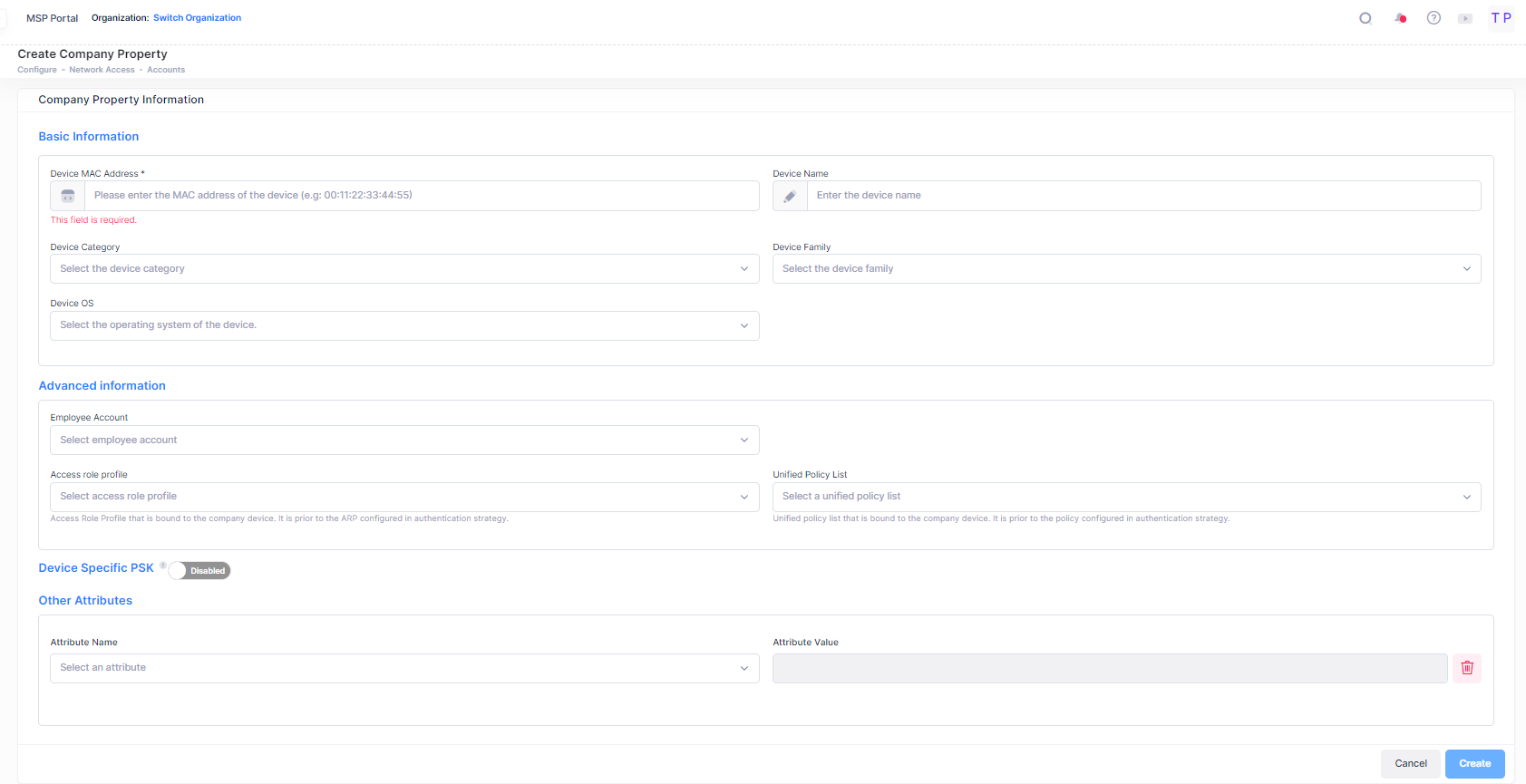
Complete the following fields as described:
Basic Information
Device MAC Address - MAC address of the company device.
Device Name - System name of the company device.
Device Category - Category of the company device:
Computer
Mobile
Tablet
Game console
Digital media receiver
Others
Device Family - Production vendor of the company device:
Alcatel-Lucent Enterprise
Apple
Samsung
Huawei
Microsoft
LG
Lenovo
HP
IBM
Nokia
MI
HTC
Sony
Blackberry
Others
Device OS - Operating system of the company device:
Linux
Windows
MacOS
Android
IOS
Others
Advanced Information
Employee Account - The employee account to which the company device is associated.
Access Role Profile - Access Role Profile that is bound to the company device. It is prior to the ARP configured in authentication strategy.
Unified Policy List - Policy List that is bound to the company device.
Device Specific PSK
Device Specific PSK - Enables/Disables Device Specific PSK. Device Specific PSK provides more security than traditional PSK. If Device Specific PSK is enabled on a wireless network and Device Specific PSK is enabled for the device, when the AAA Server sends the RADIUS Access-Accept for MAC Authentication for the device, it will also send the specific pre-shared key for that device, differentiated by the device's MAC Address. This means that each device will have a different key. When Device Specific PSK is enabled for the company property device, complete the following fields:
Passphrase - The Device Specific Passphrase.
Passphrase Retype- Re-enter the Passphrase.
Generate Random Passphrase - Click on this option to automatically generate a passphrase for the device. The passphrase will be entered in the Device Specific Passphrase fields.
Passphrase Validity Period - Select the duration for the Device Specific Passphrase (Always Valid or Custom - configure a specific date and time for the validity period to expire).
Other Attributes
Attribute Name - Select an attribute name from the drop-down menu list.
Session Timeout - The Session Timeout Interval is the maximum number of consecutive seconds of connection allowed to the user before termination of the session or prompt. If not configured, the device’s default session timeout policy will take effect. (Range = 12000 - 86400, Default =43200)
Accounting Interim Interval - Interval for RADIUS accounting, in seconds. If not configured, the device’s default accounting policy will take effect. (Range = 60 - 1200, Default = 600)
WISPr Bandwidth Max Up - The user upstream bandwidth, in kbit/s. By default, it is not limited.
WISPr Bandwidth Max Down - The user downstream bandwidth, in kbit/s. By default, it is not limited.
Tunnel Private Group ID - The Tunnel Private Group ID is used to determine the UNP for the device, if applicable. It is a RADIUS attribute that indicates the group ID for a particular tunnel session. It may be included in the Access-request packet if the tunnel initiator can pre-determine the group resulting from a particular connection, and should be included in the Access-Accept packet if this tunnel session is to be treated as belonging to a particular private group. In most cases, L2 VLAN domain is a private group, and the Tunnel Group ID is pointing to the VLAN ID. (Range= 1-4094).
Attribute Value - Enter the value required for the selected Attribute Name.
After you have finished completing the field values, click on Create to add a device.
Import Company Property from an Excel Sheet
To import multiple company properties from an existing Excel sheet (.xlxs), click on Import from… and select XLSX template file. You will then be prompted to download an XLSX template file that contains steps on how to add the company property in the Excel file to create multiple company properties .

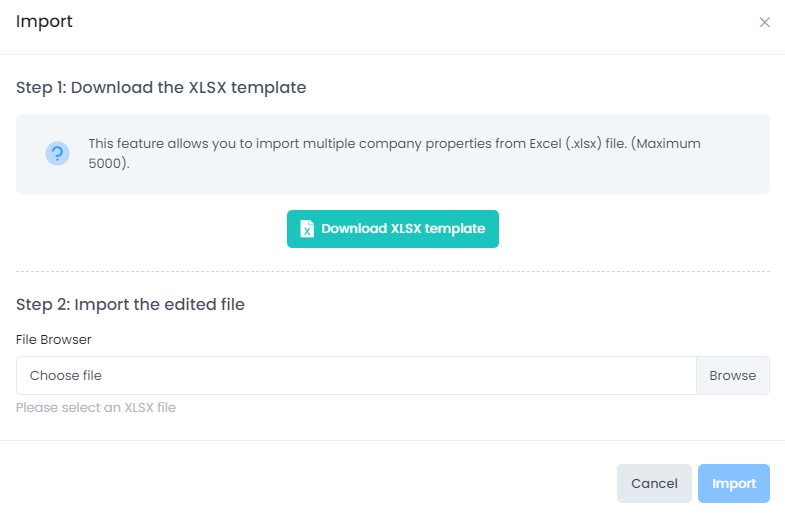
Step 1: Click on Download XLSX template and specify where you would like to save the template file. When you open the template file, instructions are provided about how to define the company property to be added.
The following sample template file is an example of the template provided for add company property.
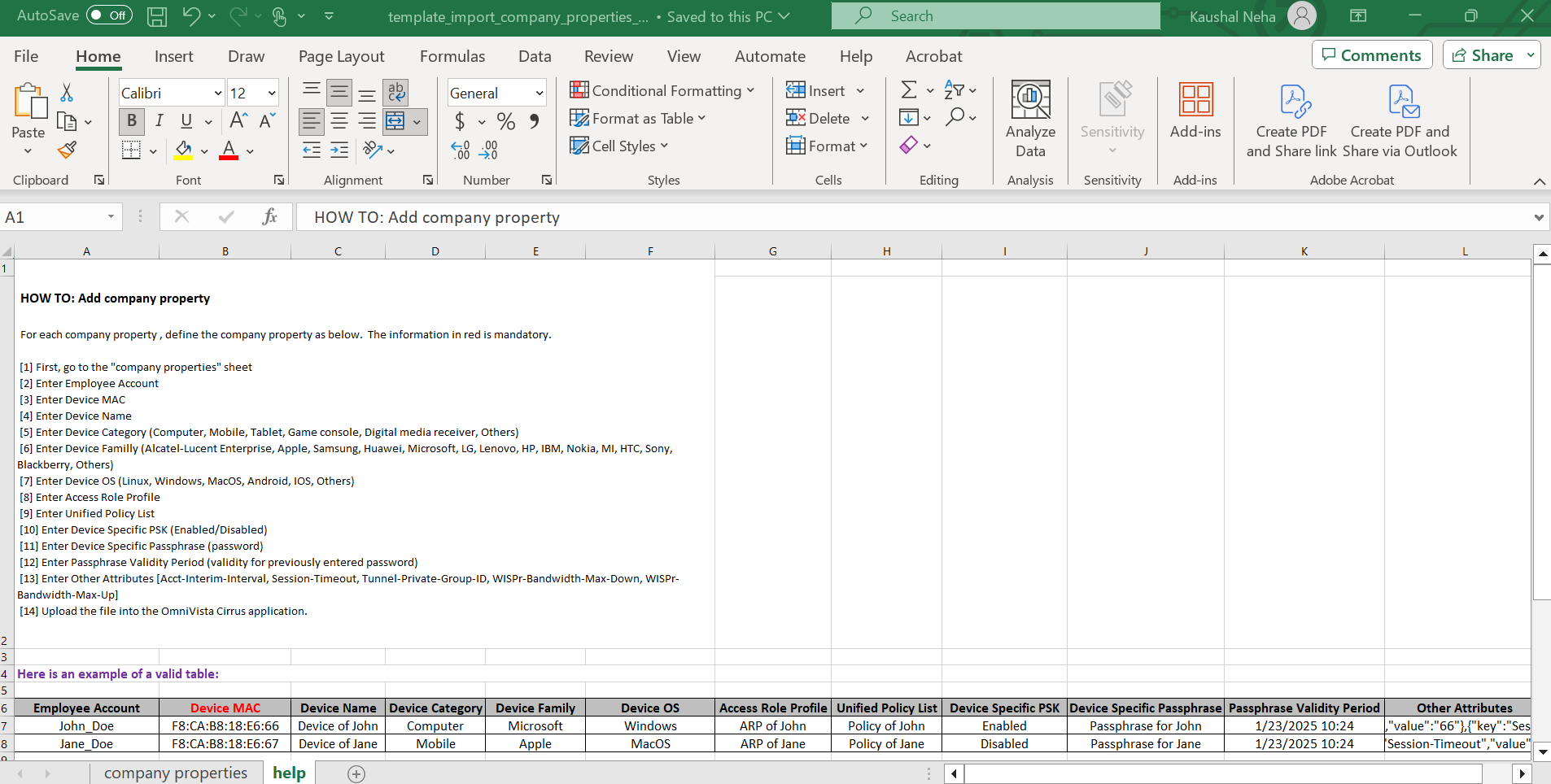
Fill out the template with information for each company property that is to be imported.
Step 2: Import the edited file and select the site of attachment
File Browser - Click in this field to find and select the existing template file to import.
Once the Import form is complete, click on Import. The Company Property list is populated with the imported Company Properties.
Import the Company Property from CSV File
To import multiple company properties from an existing .csv file, click on Import from… and select CSV template file. You will then be prompted to download the CSV template file that contains steps on how to define the company property from a csv file to create multiple company properties.

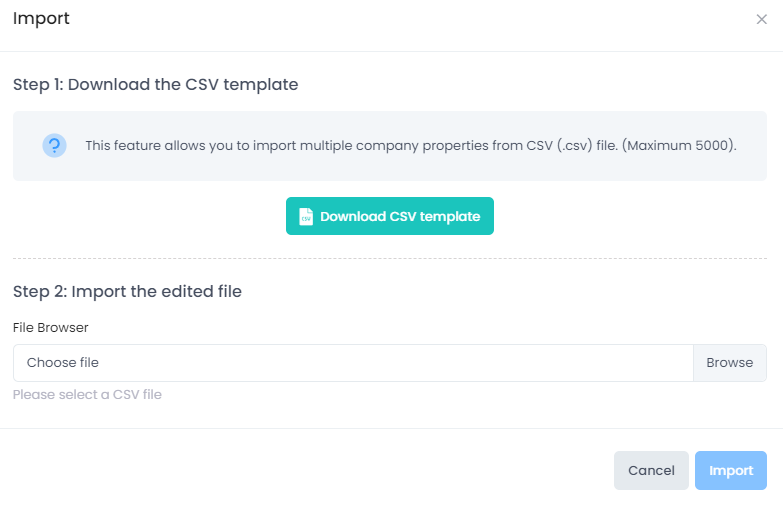
Step 1: Download the CSV template file and add company property information based on the template instructions.
Step 2: Import the edited file and select the site of attachment
Complete the following fields as described to select and upload the CSV file.
File Browser - Click in this field to find and select the existing CSV file to import.
Click on Import. The company property list is populated with the imported company properties.
Editing a Company Property Entry
You can edit the parameter values for a Company Property entry by accessing the Edit Company Property screen.

Use one of the following methods to access the Edit Company Property screen (as shown above):
Select the Company Property to edit by clicking on the checkbox next to the Employee Account, click on Actions, then select Edit from the drop-down menu.
Click on the pencil icon under the “Actions” column next to the Company Property that you want to edit.
The following Edit Company Property screen displays. Edit the fields as described above, then click on Save.
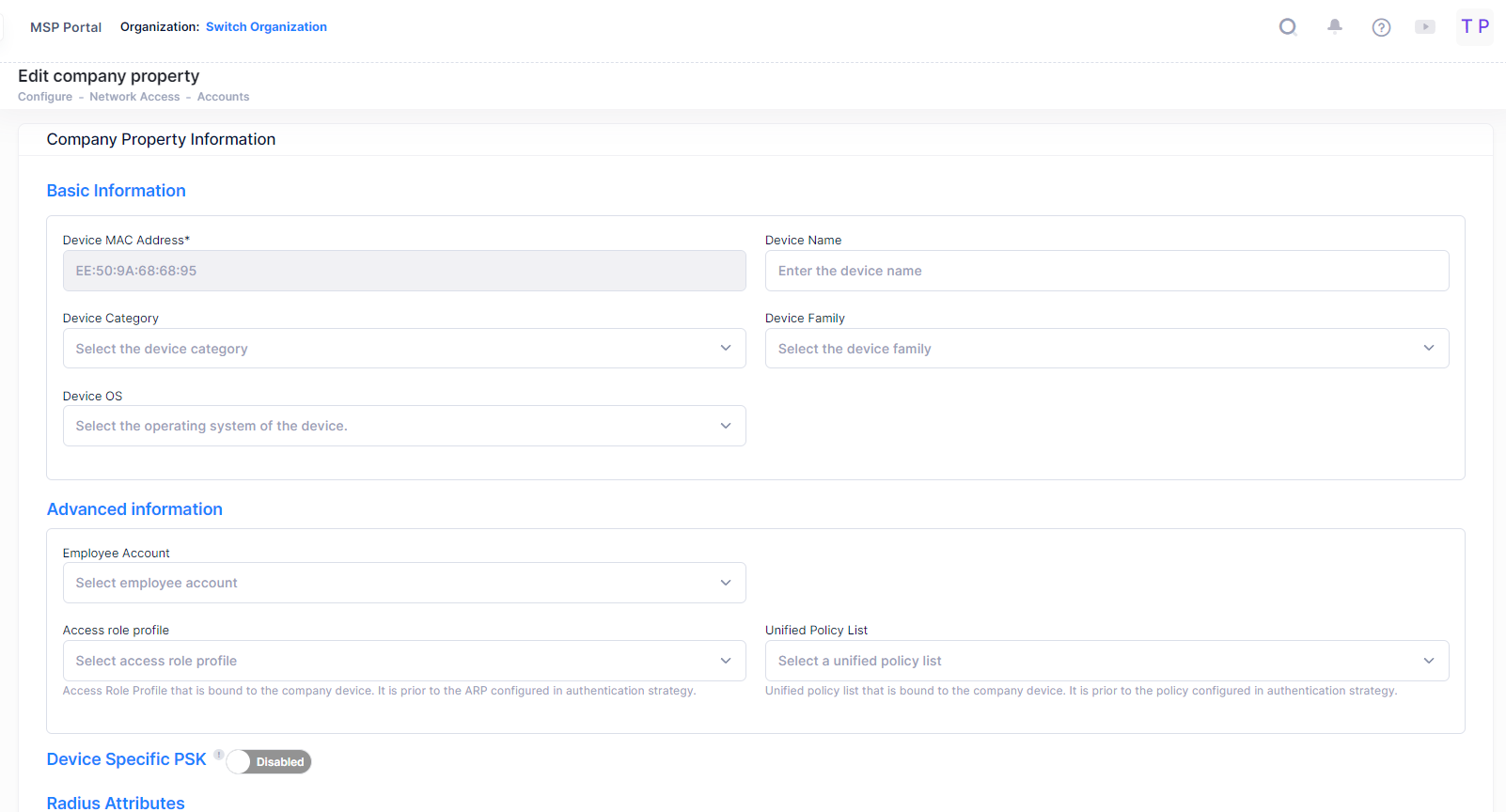
Note that you cannot edit the Device MAC address.
Deleting a Company Property Entry
To delete a Company Property Entry, use one of the following methods to select the Company Property you want to delete:
Select a Company Property to delete by clicking on the checkbox next to the Employee Account, click on Actions, then select Delete from the drop-down menu.
Click on the trash icon under the “Actions” column next to the Company Property Entry that you want to delete.

When you select the Company Property Entry you want to delete, the following confirmation prompt appears:
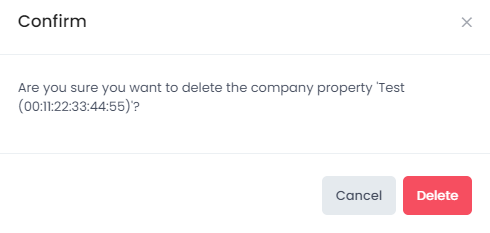
Click on Delete to confirm that you want to delete the Company Property Entry.
Print QR Code of DSPSK of a Company Property Entry
You can Print QR Code of DSPSK for a Company Property entry by accessing the Print QR Code of DSPSK screen.

Use one of the following methods to access the Print QR Code of DSPSK screen (as shown above):
Select the Company Property by clicking on the checkbox next to the Device MAC Address, click on Actions, then select Print QR Code of DSPSK from the drop-down menu.
Click on the print icon under the “Actions” column next to the Company Property that you want to Print QR Code of DSPSK.
The following screen appears. Enter the SSID from the drop-down list or click on Create SSID button, which launch the Create SSID screen in a new tab and you can create a new SSID profile from that screen, then click on OK to save the changes.
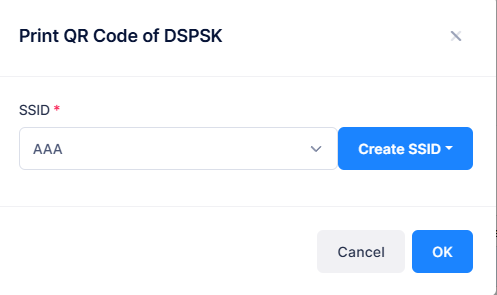
Send QR Code of a Company Property Entry to Employee Account
You can send the QR Code for a Company Property entry to an Employee Account by accessing the Send QR Code screen.
Select a Company Property entry from the List and click on Actions to open the Actions menu, Select “Send QR Code” option from the drop-down menu.

The following screen appears. Enter the SSID from the drop-down list or click on Create SSID button, which launch the Create SSID screen in a new tab and you can create a new SSID profile from that screen. The employee account of the selected company properties will receive a QR code by the email. You can click on OK to save the changes.

Display Company Property List
The Company Property List displays information about company property that can be assigned to employees. To display detailed information about a specific profile, click on the Additional Information icon under the “Actions” column.

For each of the configured Company Property entry for an employee, the following attributes values are displayed:
Employee Account - The employee account to which the company device is associated.
Device MAC Address - The MAC address of the company device.
Device Name - The system name of the company device.
Device Category - The category of the company device (e.g., Computer, Mobile Tablet).
Device Family - The Production vendor of the company device (e.g., Alcatel Lucent Enterprise, Apple IBM).
Device OS - The operating system of the company device (e.g., Linux, Windows, IOS).
Device Specific PSK - The administrative status of Device Specific PSK for the device (Enabled/Disabled).
Status - The operational status of the device (Online/Offline).
Access Role Profile - Access Role Profile that is bound to the company device. It is prior to the ARP configured in authentication strategy.
Policy Name - Policy Name that is bound to the company device.
Passphrase Validity Period - The duration for the Device Specific Passphrase (Always Valid or a specific date and time for the validity period to expire).
Created At - The date and time of the creation of the company property account.
Other Attributes - The attribute name (Session Timeout/ Accounting Interim Interval/WISPr Bandwidth Max Up/ WISPr Bandwidth Max Down) and attribute value in Kbit/s (default value is set to 0).
